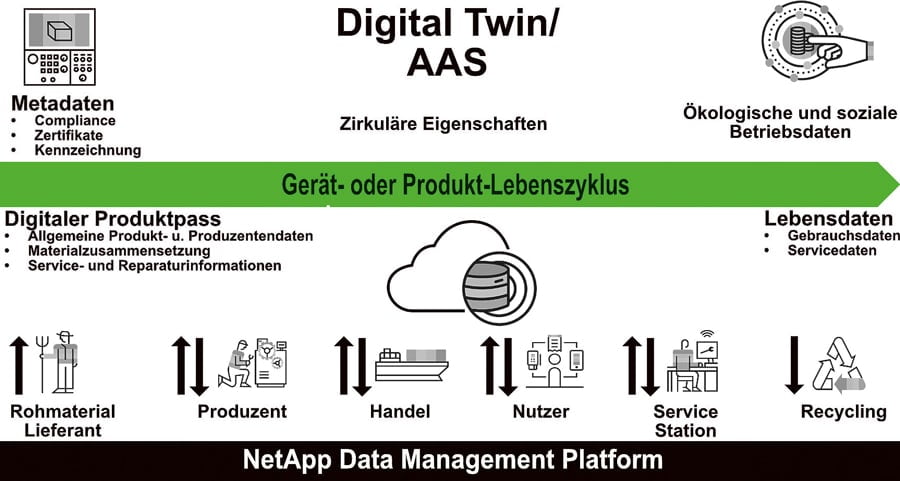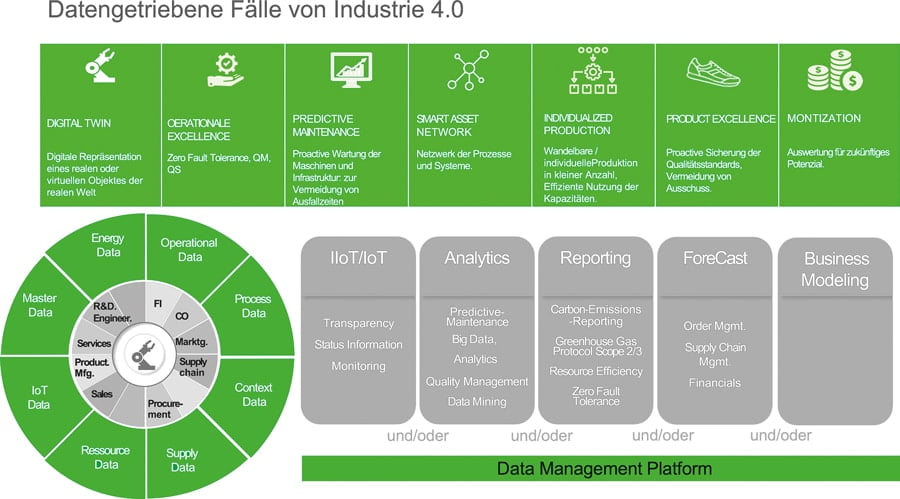Environment - Social - Governance (ESG)


NetApp and SAP Shape a Digital Future in the Industry 4.0 Environment
On a global level, Environment, Social and Governance (ESG) ensures that companies act more sustainably; on a regional level, EU taxonomy and the Supply Chain Act, and on a national level, the German Supply Chain Sourcing Obligations Act (LkSG). Software groups such as NetApp and SAP create the conditions for companies to achieve a symbiosis of digitization and sustainability.
ESG evaluates corporate social responsibility, i.e. the voluntary contribution of business to sustainable development that goes beyond the legal requirements. This is linked to a responsible corporate attitude in investments made, "Socially Responsible Investing". ESG criteria are included by investors in the analysis of securities in order to take into account and evaluate the social, ecological and ethical consequences of investments in companies and countries.
In Europe, the so-called EU taxonomy has been taking effect since 2022 as part of the Green Deal, in order to also direct capital flows from private investments into ecologically sustainable economic activities. Globally and regionally, the noticeable shift in society toward more conscious action and consumption on the capital market is showing a clear shift toward sustainably managed investments. Sustainability is becoming a criterion of risk management in the financial industry.
Supply chain laws create a legal framework for due diligence along the entire supply chain and stand for the protection of workers worldwide. For companies, this leads to new obligations: Suppliers must be audited for compliance with minimum social and environmental standards of a fairer and more sustainable global economy to promote responsible corporate governance.
The Twin Transformation combines digitization and sustainability. In the times of increased digitization, it is therefore to be understood that the digital transformation and the green transformation (the implementation of sustainability goals) lead a symbiotic relationship. The resulting "Twin Transformation" determines the investments and the evaluation of sustainable economic actions of companies by the financial market.
Companies that tackle digitization and sustainability together are two and a half times more likely to be among the successful companies of the future. This is because Twin Transformation encompasses a triumvirate of opportunities: positive representation to the financial markets by increasing their own profitability while acting in a socially and ecologically responsible manner.

Social and ecological action is not limited to our own company, but also applies to our influence on customers or partners. SAP and NetApp implement this on their own as well as in their different relationships with each other.
For example, on its ESG page for investors, SAP writes: "Our sustainability agenda is a central element of our corporate purpose and is firmly anchored in our strategy. We want to bring about positive change on our planet in terms of the economy, the environment, and society. We can achieve this through our business activities in two ways - by creating the conditions for sustainability among our customers and by living sustainability ourselves."
George Kurian, CEO of NetApp, states in the ESG Report 2021: "For the benefit of our employees, customers, partners, shareholders, and neighbors, we are committed to effective environmental, social, and governance (ESG) management."
Setting an example of sustainability
SAP, in its role as a sustainable role model, has for years demonstrated the linkage of economic, environmental, and social performance and leadership in integrated reporting. This enables the company to make better decisions. For holistic management, SAP has, among other things, set clear targets for key non-financial indicators. SAP has received excellent ratings for this: in the Dow Jones Sustainability Index as the most sustainable software company; from Morgan Stanley Capital International with the top rating AAA in ESG; from Sustainalytics in the first percentile within the industry; from ISS ESG with a prime rating in the first decile.
Similarly, in its 2022 ESG Report, Net-App prioritizes and categorizes its sustainability goals, which are integrated throughout its business processes, for stakeholders and its own business. NetApp also has itself assessed continuously (every twelve months) on the EcoVadis platform. In the latest score, the company increased its previous year's result by six points and rose to the top seven percent of the companies assessed, receiving a gold medal.

According to conservative estimates, commercial IT will account for around eight percent of global energy consumption in 2030. By comparison, this figure was two percent in 2020. In 2020, according to the digital association Bitkom, this would mean total energy consumption of 16 billion kW/h and greenhouse gas emissions of 6.09 million tons of CO2 in Germany alone (with a simultaneous 21 percent increase in the efficiency of data center infrastructures).
To slow this trend, NetApp became the first storage-focused vendor to join an MIT consortium to develop PAIA. The user-friendly tool identifies the environmental footprint of information and communications technology (ICT) products throughout their lifecycle. NetApp also complies with sustainability standards such as ISO14001, WEEE, RoHS, and REACH, and provides customers with a free "Environmental Dashboard" that measures the energy consumption of each array in real time.
The key figures and external evaluations reported by NetApp can be used for a listing in green IT purchasing portals under aspects of supplier evaluation. This is because within a product passport, manufacturing conditions, manufacturer proofs, manufacturing components, and pure operating components are shown to be at least climate-neutral.
To measure the further sustainability promises of NetApp's systems and software solutions residing on them, data management must be evaluated in addition to considering IT infrastructure measures for energy efficiency. Data storage accounts for around 15 percent of the energy consumed by data centers - a not inconsiderable amount. Based on the Bitkom study, the footprint of data storage in German data centers in 2020 amounts to around 2.5 billion kW/h of energy and at least 1 million tons of CO2 emissions.
This means that, in addition to energy efficiency, data efficiency is also of fundamental importance: data quantity, because the most climate-friendly way to store data is to store no data, and if data is stored, then the right data (no data waste); data privacy ensures access to central storage locations (no data copy), and data cloud and data mesh ensure access between on-prem and cloud (data federation).
NetApp's capabilities are deployed in numerous solutions provided by SAP in the cloud, and it contributes to the picture of a more climate-friendly data center operation with various aspects. But energy and data efficiency measures alone are not enough; they only postpone the inevitable.
Data balance and data effectiveness
In some industries, 80 percent of all transactions run through SAP systems. However, if we only consider the growth of commercial data in relation to the growth of the transaction data of the SAP systems structuring it, the exponential increase cannot be explained. This only arises as a result of the rapid growth in digitization.
Omnipresent connectivity and innovative technologies mediate between people, places, products and systems, creating smart assets, smart products, plants, buildings, materials and processes. They are key features of the fourth industrial revolution with the fundamental idea of full-scale networking. Companies connect master data with movement data of everyday consumer behavior, measure, weigh and count - because manageable is only what can be tracked.
For many companies, one of the attractions of Industrie 4.0 is to develop new data-based business models by bringing together IT and OT (operational technology) data and integrating them into SAP systems. The integration of data from IT with data from OT also creates new opportunities in data analysis. NetApp is currently making the leap into practice here in Germany: with smart maintenance without fixed maintenance cycles, for example, for bridge infrastructure in cooperation with the University of the Federal Armed Forces in Munich. Another example: With an international automotive supplier, the virtual commissioning of production line expansions is being considered. In this way, production changes, prototypes and effects on the supply chain can be simulated and implemented during ongoing operations.
Digital twins map the entire process in virtualized form, test the process maturity and thus shorten the time to commissioning. The data standardized via management shells/digital twins from BaSyx and provided with metadata are stored in an object data store from NetApp. Digital data from different sources, for example sensor technology, can be easily recombined for further processing using appropriate metadata and made available to both local and cloud-based SAP applications via the standard interfaces.
The next collaborative step between NetApp, SAP, and other integration partners can be a holistic cloud-based manufacturing marketplace. Customers define their production requirements on an international portal that knows the capacity utilization, vertical range of manufacture, raw material and supply chain, and all other relevant parameters of the participating companies, and then award the contract to the cheapest, most sustainable, or fastest provider in the pool. Such scenarios are already being worked on within the framework of Gaia-X or Catena-X.
Data effectiveness and eco-effectiveness
Combining digital transformation with sustainability principles in a data-effective way is another important and timely contribution by NetApp. The symbiosis of green and digital transformation is referred to as "Twin Transformation" due to the many common interfaces. Particularly in European countries, this symbiosis offers great opportunities due to the head start in the Industrie 4.0 context. In the Twin Transformation, the digital and sustainable business models are considered, integrated, built and operated together.
The digital twin becomes a "sustainable digital twin", a digital business model becomes a digital sustainable model, which is extended by the economically significant term eco-effectiveness. The digital twins enable IFTTT analyses, OEM and rental models, and write transaction-oriented sustainability data about raw material, producer, transport and logistics, trade, user, service, and recycling - in other words, the entire life cycle - into the connected systems.
Digital twins can thus be transformed into sustainable financial objects in a further transformation phase and assigned to accounts via the SAP Sustainable Control Tower. SAP Product Footprint Management is supported not only for installed components but also at the production or machine level, bringing Responsible Design and Production closer to reality.





